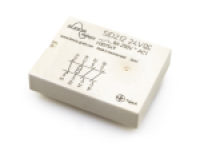聯系電話:0755-84552801
手機號碼:18926061910





| - SID 3 系列
|
新繼電器SID3系列是雙電樞繼電器,根據IEC61810-3 A標準,配備了兩個獨立的強制導向觸點組。繼電器可用于功能安全的雙通道控制架構,例如SIL3(IEC 61061)或Pl“e”(ISO 13849)。
與具有兩個可比較的傳統繼電器的解決方案相比,面積節省約18%。由于觸點組的內部布線和只有一個電磁線圈,PCB上的孔數量從16個減少到8個。與2片SIF212相比,繼電器的塑性含量可減少23%(繼電器重量減輕7%),在繼電器殼體下為高度不超過約3 mm的部件創建了兩個裝配區域。相比之下,線圈功率可以減少約37%。額定功率為750毫瓦。線圈電壓為5伏直流電至110伏直流電。
除了焊接安裝外,ELOPINS(壓合技術)也是一種無焊接安裝技術。壓配合觸點可確保與PCB的氣密連接。這與高連接質量和節省資源齊頭并進,因為不需要焊接工藝。 可獲得UL和TüV的批準。 The new relay series SID3 is a double armature relay, which is equipped with two independent forcibly guided contact sets according to IEC 61810-3 type A. The relays can be used for example for 2-channel control architectures of functional safety e.g. SIL3 (IEC 61061) or Pl "e" (ISO 13849). Thus, among other things, 2-channel control architectures of functional safety, e.g. SIL3 (IEC 61061) or Pl "e" (ISO 13849) can be realised.
The area saving compared to solutions with two comparable conventional relays is around 18%. Due to the internal wiring of the contact sets and only one solenoid coil, the number of holes on the PCB is reduced from 16 to 8. The plastic content of the relay could be reduced by 23% compared to 2 pieces of SIF212(7% weight reduction of the relay), Two assembly areas for components up to a height of approx. 3 mm were created under the relay housing. In comparison, the coil power could be reduced by about 37%. The nominal power is 750 mW. Coil voltages from 5 VDC to 110 VDC are available.
In addition to solder mounting, ELOPINS (press-fit technology) is available as a solderless mounting technique. The press-fit contacts ensure a gas-tight connection to the PCB. This goes hand in hand with high connection quality and saves resources, as there is no need for a soldering process.
Approvals from UL and TüV are available. | |





